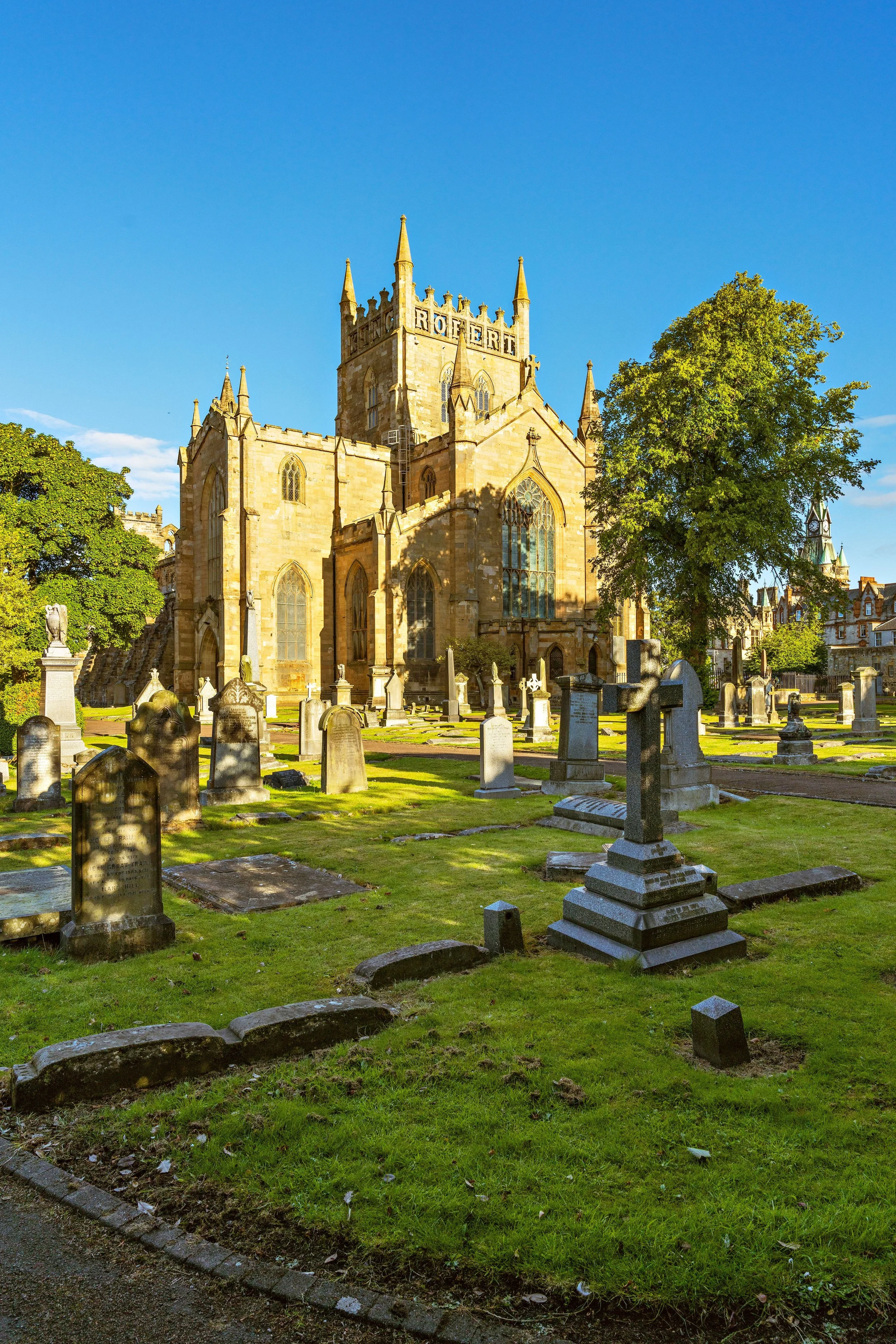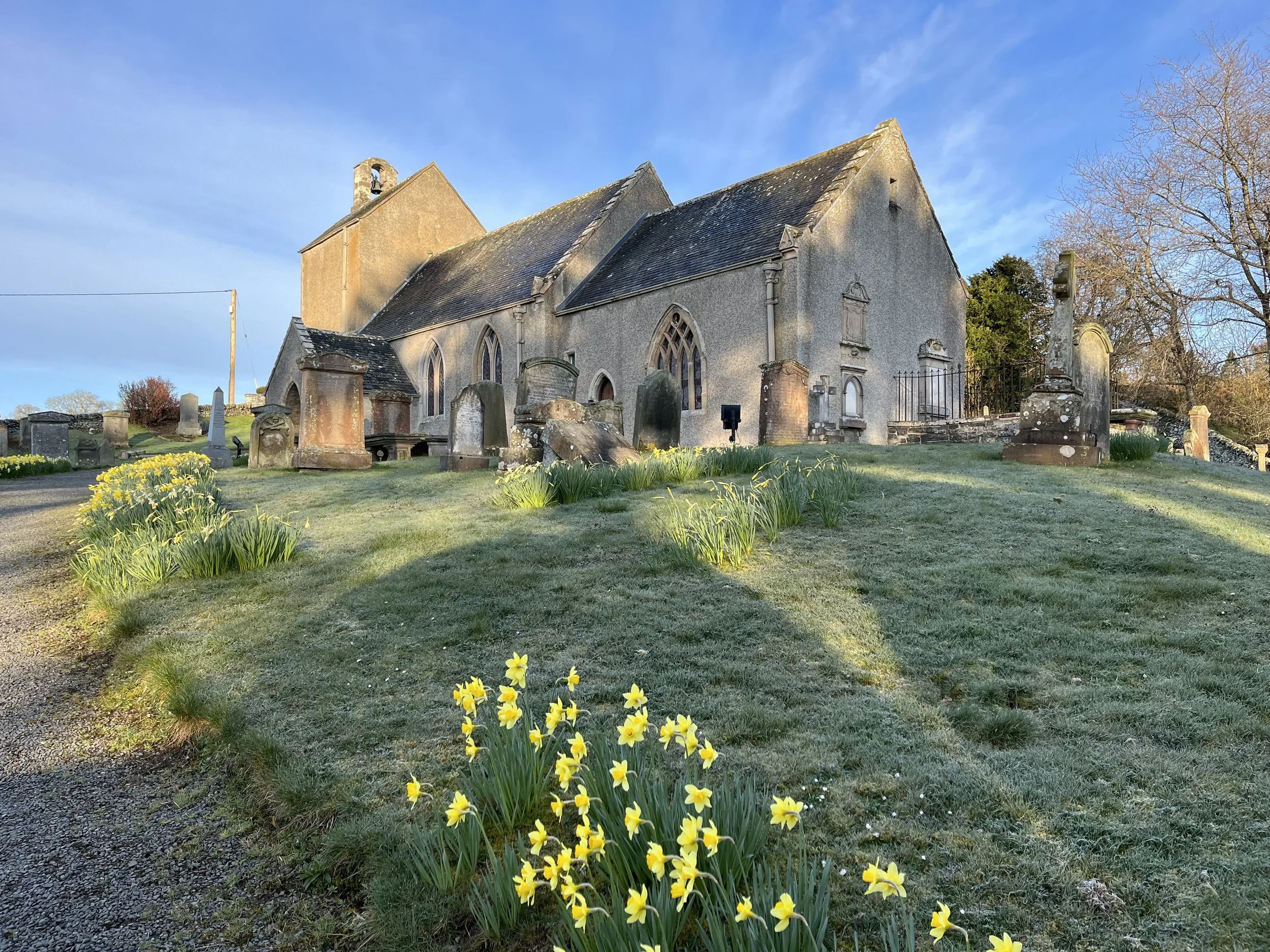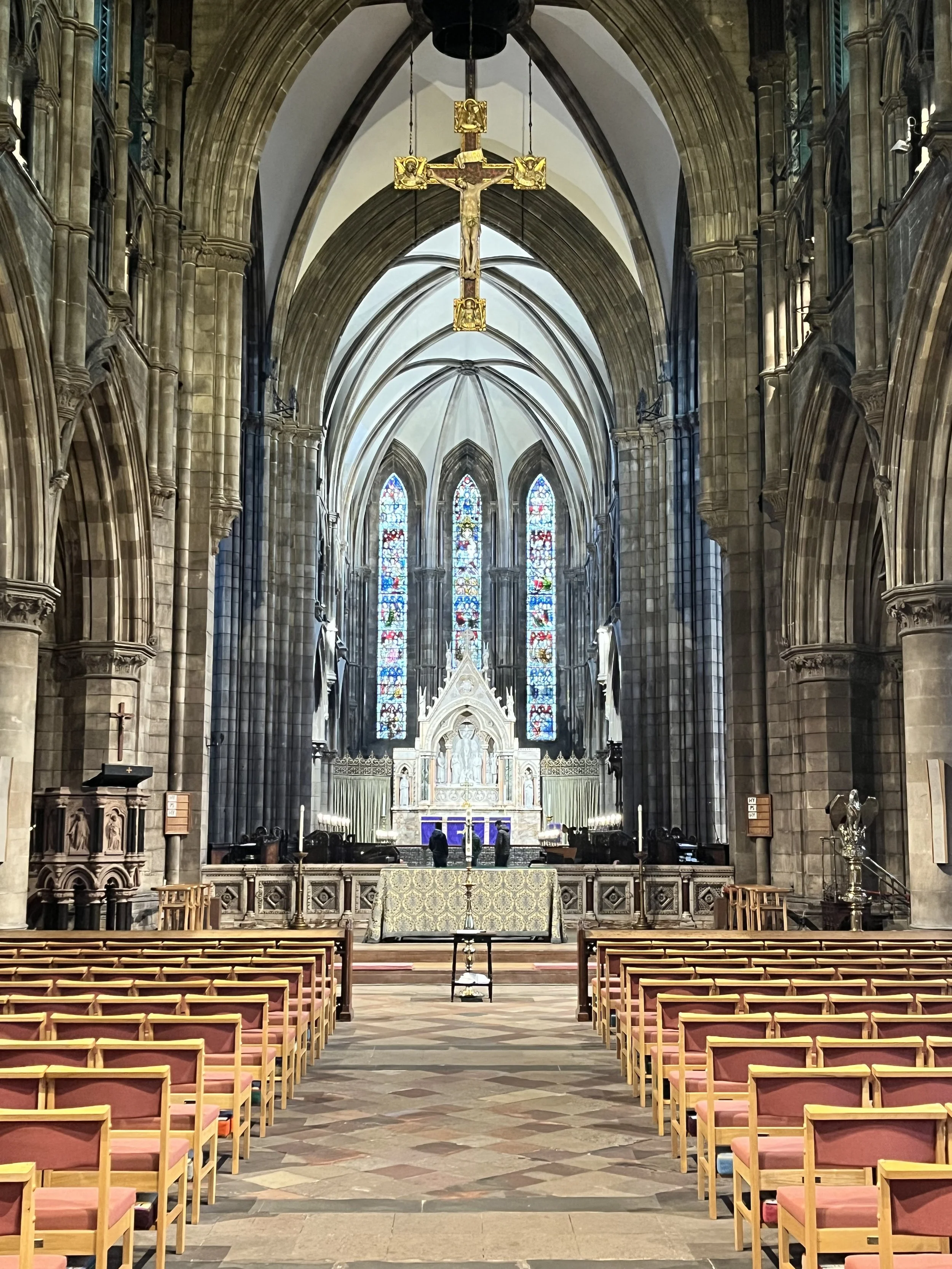Beyond Rosslyn - Discovering Scotland’s Wonderful Kirks
In 2003, the book world was introduced to Dan Brown's thrilling novel, "The Da Vinci Code". Since then, it has become a household name, selling over 80 million copies worldwide and earning a permanent spot on charity shop shelves. The book is full of exciting (and a bit daft) conspiracy theories featuring a climax set in the very real Rosslyn Chapel, located just outside Edinburgh. Prior to the release of Brown's novel, Rosslyn Chapel received a respectable number of annual visitors, approximately 30,000. However, after the novel's publication and the subsequent movie featuring Tom Hanks, visitor numbers skyrocketed. Even today, in the post-pandemic era, the Trust that manages Rosslyn reports receiving around 180,000 visitors per year. While Brown's book, which suggests that the Holy Grail of Christ was hidden in the Chapel, certainly played a role in this success, visitors are also drawn to the Chapel's stunning masonry and enigmatic carvings. For anyone visiting Edinburgh or the East of Scotland, Rosslyn Chapel is an absolute must-see. As a local, I've taken visitors there and have a trip planned for next month - it truly is a remarkable experience. However, this blog aims to take you Beyond Rosslyn and explore even more of Scotland's stunning religious sites and churches. The focus is on a rough radius of an hour (ish!!!) from the Capital, so don't email asking why Whithorn, Iona or St Magnus didn't make the list! Join me on this journey to uncover the Christian spirituality, history and beauty of South East Scotland, and let me know what you think of the sites I've included, all of which are available to visit with TVB Tours.
You’ll find a Google Map of all the locations at the end of the blog. Please respect these important sites, most of which are still active places of worship or important sites of pilgrimage.
The East Neuk - St. Monan’s Kirk & St. Andrew’s Cathedral
The Kirk at St. Monan’s is truly striking, and few in Scotland can have such a stunning setting. As is fitting in the Kingdom of Fife it has many royal connections, going as far back as David II in the 14th century and is a welcome site for those undertaking the Fife Costal Path. It is still an active Church of Scotland Parish Church.
St. Andrew’s Cathedral has been a place of pilgrimage for more than a millennium as it was reputed to hold the relics of Andrew, apostle of Christ who would in time be adopted as our Patron Saint. At one time it was the largest Church in Scotland, home to Bishops and Archbishops. Throughout Medieval Scotland, this was a seat of great power and only after the reformation did it fall into ruin. Today the remains hint at the vast scale of what was once a great monument to the power of Medieval devotion.
Both these Churches feature on our East Neuk & St Andrews tour.
The Kingdom of Fife - Dunfermline Abbey & Burntisland Parish Church
Dunfermline Abbey
I was delighted when Dunfermline was given city status in the Queen’s Platinum Jubilee year 2022. The Abbey’s website states this has been a worshiping community since 1072, so clearly there is a wealth of history to be found here - much later a Palace was added and Charles I was born here, the last monarch born in Scotland. The Abbey still operates as a Parish Church, however large sections are under the care of Historic Environment Scotland (with restricted access, sadly). The list of Medieval monarchs buried here is significant. A great place to spend a morning exploring before heading along the coast to Burntisland…
Burntisland Parish Church is a much smaller building than Dunfermline Abbey, but of historical importance in its own right - this was the first new Church built after Scotland’s reformation. It dates back to 1592 and it was here that a new version of The Holy Bible was unveiled, in the presence of King James VI of Scotland - known to history as the King James Bible, and a cornerstone of Christian worship to this day. The significance of Fife in Scotland’s story cannot be understated, so what are you waiting for - discover the Kingdom today!
Linlithgow Shire - St. Michael’s Church, Abercorn Parish Church & St. Cuthbert’s Dalmeny
Crossing the Forth we enter West Lothian, historically known as Linlithgow Shire. Heading for Linlithgow itself, your eyes will be drawn to the unique Steeple of St. Michael’s Church, at the gate to the magnificent Linlithgow Palace. The Palace is inextricably linked with the Stewart Kings (and Queen) and both it and St. Michael's have roots back to the Middle Ages. The Steeple represents Christ’s crown of thorns and was installed in the 1960’s by the then Minister Dr David Steel - father of Lord Steel of Aikwood. It has itself become iconic and was restored a few years back.
You can visit the Church on Saturday and Sunday mornings.
St. Michael’s, Linlithgow
Heading back towards Edinburgh I want to show you two smaller Churches. Firstly Abercorn Parish Church, tucked away (and not that easy to find!!) on the Hopetoun Estate. I love this wee Kirk, which is beautifully situated among trees and on inspection of the stone & architecture you will be in no doubt of its great age. This is just the tip of the iceberg though - we know St. Ninian established a mission here in the 400’s (!) and there is evidence of Anglian and Viking occupation of this site.
The Church is generally open during daylight hours.
Abercorn Church
Finally in this part of the world, I want to recommend Dalmeny Parish Church - Scotland’s finest Norman Church which, like Abercorn, has roots stretching further back into the mists of so called dark ages Scotland. The Church is dedicated to Saint Cuthbert (more of him later!) and the interior will take your breath away. It is open for visitors every Sunday from April to October from 2.00pm until 4.30pm, however even the exterior is well worth your time and makes a great detour when viewing the nearby Forth Bridges at South Queensferry.
TVB Tours can also take you to all the West Lothian highlights on a Bespoke Tour.
The Lamp of Lothian - St. Mary’s Haddington & Humbie Parish Church
Heading to East Lothian, we visit St. Mary’s in Haddington - a Parish Church on the scale of a Cathedral. It was built in the 1300’s before being left devastated in the ‘Rough Wooing’ which destroyed large swathes of South East Scotland in the 1540’s. The church is known affectionately as The Lamp of Lothian and it was to shine brightly again post reformation, having links to Haddington born reformer John Knox. The last time I visited I couldn’t get in due to filming taking place (for a project the filmmakers would not divulge!) but normally visitors are welcomed and it is stunningly situated next to the River Tyne in this historic market town.
St. Mary’s, Haddington
Humbie is on a much smaller scale, but what it lacks in size it compensates for in charm and a sense of peace. Humbie is easily accessed from the A68 road, and the Kirk itself is a little out of the village, down into one of the wooded groves that the Lothians do so well. Only the trickle of the Humbie Water and chatter of birdsong disturb the peace of Humbie Kirk. You will immediately be charmed with the situation, and the kirkyard itself (accessed through an ancient stone arch) is full of interesting memorials, including a man playing Northumbrian Pipes! The main Kirk building dates to 1800 and is gothic in style, with later work being completed by David Bryce, architect of Glen House. A large window depicts scenes from the life of King David I, later canonised and responsible for many of the religious buildings in Scotland during his reign which began 900 years ago.
Discover more Hidden East Lothian on our special tour.
Humbie Kirk
Berwickshire and The Border - Dunglass Collegiate Church, Coldingham Priory, Ladykirk ‘Kirk of Steill’ & St. Cuthbert’s Norham
Heading along the coast from East Lothian towards Berwickshire, you'll come across a sign for Dunglass and Oldhamstock. The road you'll take is the slightly worn former path of the Great North Road, nestled between the modern A1 road and the East Coast mainline railway. Follow this road for a few miles, and you'll feel like you've stepped back in time... Dunglass Collegiate Church is situated within the lush Dunglass Estate, renowned as one of the top wedding venues in the country. After losing much of its wealth post-reformation, the church was eventually repurposed, even serving as a barn at one point. Today, the Church and Estate are under the care of the Usher family and are open for respectful visits. Keep an eye out for the Knights Templar crosses, adding an intriguing touch for mystery enthusiasts - although there's no confirmed link between the Templars and Dunglass, their presence adds an extra layer of enigma to the place!
Down the coast you can visit Coldingham, and explore the historic Coldingham Priory ruins and modern Church. The site reflects early Christianity, invasion, destruction, and reformation - recurring themes! Inside the Church, ancient priory walls are integrated into the structure, creating a blend of historic and modern elements.
Heading to within a stones throw of the English border, where a church in Ladykirk, Berwickshire, named Our Lady Kirk o' Steill, was ordered to be built by King James IV after a near drowning incident when fording the River Tweed. The church features a bust of the King and a unique vaulted stone roof. Local traditions include claims of 365 steps around the church exterior, symbolising each day of the year - a claim I refute, but it makes a good story!
Finally before leaving this turbulent borderland, I suggest a quick nip across to Norham (via the Ladykirk/Norham bridge, not the James IV ford..) Here we will find another St. Cuthbert’s Church, and what a beauty it is. Have a watch of this short reel I created on Instagram, in praise of St. Cuthbert’s…
St. Cuthbert’s Scotland - Channelkirk and Old Melrose
After exploring several St. Cuthbert’s Churches in previous posts, it's time to delve deeper into the life of the man himself. Born near what is now known as the Lammermuir hills of Scotland, which was part of the Anglo-Saxon kingdom of Northumbria in the mid-600s AD, Cuthbert is perhaps considered a ‘lost’ Scottish saint, given he is so associated with North East of England. Traces of his presence can still be found in Scotland however, with the narrative possibly beginning at Channelkirk, a solitary church near Oxton. While the current church was constructed over a thousand years after Cuthbert's era, tradition has it that he performed baptisms near here and discovered his vocation to serve Christ while tending sheep in these hills (a nearby plaque tells of Cuthbert’s baptisms). ‘Tradition’ may be elusive, but a visit to Channelkirk, situated next to the Roman Road of Dere Street, can evoke the pastoral and spiritual essence of this serene location. You'll also encounter one of the finest examples of a mortsafe in the country, metal devices used to prevent body snatching until the 1832 Anatomy Act brought an end to this gruesome practice.
The Church is occasionally open during daylight hours (it was closed the last time I went sadly).
Channelkirk
Mortsafe or Graveguard
Cuthbert left the hills to join the priory at Mailros (or Melrose as we no know it). This isn’t Melrose Abbey, we are still a mind boggling 500 years or so before David I ordered it’s construction. The site Cuthbert went to is at Old Melrose, a peninsula formed by a large loop of the River Tweed and known the world over as the foreground of the iconic ‘Scott’s View’. Nothing remains of the priory, but the grounds are open and make a nice walk on a summers day - indeed try and get a guided tour booked if you can. It is worth, of course, also visiting Melrose Abbey itself when in the area. The Abbey is the start point for the St. Cuthbert’s Way long distance footpath which follows Dere Street to the Border before crossing the Cheviot foothills and heading to Lindesfarne, the Holy Island so strongly associated with Saint Cuthbert.
Old Melrose
Merlin - Drumelzier & Stobo Kirk
Merlin, a legendary figure in British mythology, has various origins. Some believe he was a warrior in the Dark Ages Kingdom of Strathclyde, whose tale unfolds partly in Upper Tweeddale. Known as Myrddin in this version, he was driven to madness by what he witnessed during a battle in 573 AD. He sought refuge in the forests, becoming a wildman renowned for his prophetic abilities, skills as a bard, healer, and scholar. At some point thereafter he faced a local warlord at Dun Meldred fort and was sentenced to death. His resting place (supposedly) lies near the confluence of the River Tweed and the Powsail Burn. The Scottish myths surrounding Merlin are expertly chronicled in Tim Clarkson's book "Scotland's Merlin" and Robin Crichton's Merlin Trail. To explore sites associated with him in Upper Tweeddale, begin at Drumelzier, where you can marvel at the ruins of Tinnis Castle, believed to be the location of Dun Meldred. Although it does require a challenging hike to get up to Tinnis, the panoramic views of the Tweed Valley and the chance of spotting nesting peregrines make it worthwhile. Additionally, you can visit Drumelzier Kirk, a modest structure situated on the grounds of an ancient place of worship. Take note of the Tweedie family burial aisle, a very prominent Border family of Drumelzier to this day. The Kirk is typically open to visitors during daylight hours.
Loop round via Broughton to see Altar Stone, the supposed site of the baptism of Merlin by Saint Kentigern (Mungo). This road then takes you to Stobo Kirk, a real wonder of The Borders. This blog post gives you more information on this special, and ancient place. A regular stop for TVB Tours, we often visit this on the Moffat and St. Mary’s Loch excursion.
The City - Greyfriars, St. Giles ‘The High Kirk’ & St. Mary’s Episcopal Cathedral
Ending our exploration of some of South East Scotland's finest Kirks in Edinburgh, where enthusiasts of religious architecture and history have an abundance of options to choose from. With over 200 functioning churches in the city, narrowing down a selection for a blog can be quite challenging. Therefore, I'll highlight three top picks, all significant landmarks of great interest and easy to find!
Greyfriars Kirk holds a special place in the heart of Edinburgh, intertwined with the heart-warming tale of Greyfriars Bobby, the loyal wee dug who stayed by his deceased owner's side and was eventually honoured by Provost William Chambers by being made a free dog of the city. While his statue and memorial in the graveyard are notable, Greyfriars has a rich history beyond this. The church witnessed pivotal events in Scottish history, including the signing of the National Covenant. Many renowned Scots rest here, and it's become a must-visit for Harry Potter fans. During my last visit, I noticed several tour groups led by cloaked (and incredibly enthusiastic) guides, as J.K. Rowling drew inspiration from the gravestones for her phenomenally successful books. Though I may have had a twinge of tour guide envy at the muckle size of these groups, I will say that visitors with me as their guide will not only discover the Harry Potter connections but also learn about the Covenanters and the poetry of graveyard resident William Topaz McGonagall, widely considered Scotland’s worst poet. That’s bang for your buck!
Our second Edinburgh stop is St. Giles Cathedral, or the High Kirk. It is called a Cathedral but there is no Bishop here, it being the Church of Scotland. This anachronism just adds to the heritage and prestige of this wonderful place. My highlights include the window celebrating Scottish Saints, the Thistle Chapel, and the memorials to great figures in Scottish history - The Marquess of Argyll, Earl of Moray and the fascinating James Graham, Marquess of Montrose. The Instagram reel below tells you more about his story.
Before concluding this increasingly extensive blog, I suggest visiting St. Mary’s Episcopal Cathedral in the West End. This Victorian building is a very fine representation of Gothic Revival architecture. Despite being the tallest structure in Edinburgh, it offers a peaceful, intimate and serene atmosphere compared to the bustling St. Giles and Greyfriars. It's a perfect spot for contemplation and to experience the magnificent Choral Evensong, an Anglican tradition not practiced by the Church of Scotland.
St. Mary’s Episcopal Cathedral
Thanks for reading this blog, I hope it inspires you to visit some of the wonderful, historic and peaceful churches of South East Scotland. The map below shows the location of these, please be respectful when visiting these special places.
Image Credits: Dunfermline Abbey (Welcome to Fife/Luigi Di Pasquale), Abercron Church (Visit West Lothian/Vass Media), St. Michael’s Linlithgow (Visit Scotland/Kenny Lam), Old Melrose (SSDA/Duncan Ireland)
All other images and reels @tweedvalleyblogger












